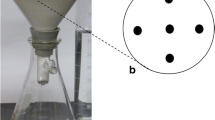Abstract
The composition of soil microbiota in four heated (350 °C, 1 h) soils (one Ortic Podsol over sandstone and three Humic Cambisol over granite, schist or limestone) inoculated (1.5 μg chlorophyll a g–1 soil or 3.0 μg chlorophyll a g–1 soil) with cyanobacteria (Oscillatoria PCC9014, Nostoc PCC9025, Nostoc PCC9104, Scytonema CCC9801, and a mixture of the four) was studied by cultural methods. The aims of the work were to investigate the potential value of cyanobacteria as biofertilizers for accelerating soil recolonization after fire as well as promoting microbiotic crust formation and to determine the microbial composition of such a crust. The inoculated cyanobacteria proliferated by 5 logarithmic units in the heated soils which were colonized very quickly and, after 2 months of incubation, the cyanobacterial filaments and associated fungal hyphae made up a matrix in which surface soil particles were gathered into crusts of up to 1.0 cm in thickness. These crusts were composed, on average, of 2.5×1010 cyanobacteria, 2.8×106 algae, 6.1×1010 heterotrophic bacteria (of which 1.2×108 were acidophilic, 1.3×106 were Bacillus spp. and 1.5×108 were actinomycetes) and 77.8 m fungal mycelium (1.4×106 were fungal propagules) g–1 crust. Counts of most microbial groups were positively correlated to cyanobacterial numbers. The efficacy of treatment depended on both the class of inoculum and the type of soil. The best inoculum was the mixture of the four strains and, whatever the inoculum used, the soil over lime showed the most developed crust followed by the soils over schist, granite and sandstone; however, the latter was comparatively the most favoured by the amendment. In the medium term there were no significant differences between the two inocula rates used. Biofertilization increased counts of cyanobacteria by 8 logarithmic units while heterotrophic bacteria, actinomycetes, algae and fungal propagules rose by >4 logarithmic units, acidophilic bacteria and Bacillus spp. by around 3 logarithmic units and fungal mycelia showed an 80-fold increase. The results showed that inoculation of burned soils with particle-binding diazotrophic cyanobacteria may be a means of both improving crust formation and restoring microbial populations.
Similar content being viewed by others
Author information
Authors and Affiliations
Additional information
Received: 8 March 2000
Rights and permissions
About this article
Cite this article
Acea, M., Diz, N. & Prieto-Fernández, A. Microbial populations in heated soils inoculated with cyanobacteria. Biol Fertil Soils 33, 118–125 (2001). https://doi.org/10.1007/s003740000298
Issue Date:
DOI: https://doi.org/10.1007/s003740000298




